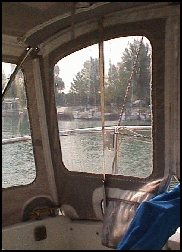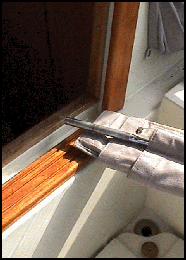Cockpit and Companionway Canvas on Flicka Ben Main Jr
By Tom Davison
Reproduced from Flicka Friends Vol. 5, # 3

From Flicka Friends Vol. 5, # 3
When approaching Richard Shepherd's Flicka, one of the first things you notice is the dodger, bimini and side/aft curtain enclosure. It completely surrounds the cockpit of s/v BEN MAIN, JR., adding another room to the Flicka.
DODGER
The first piece of the system is the dodger, which extends from mid-point of the hatch cover back past the companionway and to the winches located along the coamings.
There are five windows in the dodger, allowing good visibility. The various sheets and control lines are fed through the base of the dodger to cleats and camlocks located on the cabin roof. The center of the dodger can be opened to allow ventilation.
Richard had one suggestion about the purchase of a dodger. Leaving the cockpit and going forward requires passing the corner at the aft edge of the bimini. He felt that this was the most dangerous aspect of the trip to the bow. He recommended the addition of stainless steel handles along the aft edge and side supports of the dodger.
BIMINI
The second piece of this enclosure connects to the dodger's after edge with a zipper and a flap eliminates water flow. There are three rectangular windows on the bimini, allowing sail trim to be checked without opening a side curtain.
The aft end of the bimini is located over the stern rail. since this is a gaff rig, there are no complications with the aft rigging stay since the running backstays are placed just forward of the coamings.
For marconi rigged Flickas, the aft stay will present a problem for the aft bimini cross-bar. Either the wire must pass through the bimini, or the bimini must be angled forward along the back stay.
SIDE CURTAINS
The port and starboard side of the Flicka are enclosed using two large curtains with large areas of clear vinyl. There are snaps along the edge which allow closing the curtain without using the zippers. Another set of snaps allow you to fold the curtain aft to leave the door open. One nice touch is the small cutouts next to the cleats that allow the docklines to be used without damaging the fabric over time. There are two small flaps that close the small opening.
AFT CURTAINS
The back of BEN MAIN, JR. is enclosed using two curtains which are divided along the centerline of the boat. Again, there are large vinyl windows allow for good vision and are contoured along the shape of the bimini. There is an open area along the base of both curtains, allowing room for the tiller. Again, there is a flap that encloses the area around the tiller and rudder to prevent airflow. Again, for the marconi Flickas out there, the shorter boom would create a problem for the traveler.
While serveral windows have been replaced, the enclosure is still in service. It was built about ten years ago by Bill Buchbinder. He suggested that you seek out a good local canvas worker to build your dodger, bimini and enclosure. He said there isn't anything better than one product built just for your particular Flicka.

The wooden mast, gaff, and boom rest in the lazy jacks and clear the top of the bimini. The sails are already stored for the end of the season and the boat is being readied for indoor winter storage.
Despite the fact that many Flickas came from the same mold, the rigging and accessories make a big difference in dodger construction and fit. Mail order isn't as good as a custom product built by someone with access to your sailboat. If you have any questions, he offered to help with the answers. Contact him at:
Blue Water Sail & Canvas
10531 East Carter Road
Traverse City, MI 49684
231-941-5224


The side curtains provide a door into the cockpit and can be snapped back to leave the door open. Note the velco flap that covers the small round opening to the aft port cleat which keeps the wind out.


Since the gaff rig boom extends passed the stern of the Flicka, the traveler isn't a problem. A marconi rig would present a number of problems, not only for the traveler, but also the backstay.
Companionway Canvas


A canvas "hatchboard" system allows fresh air to circulate aboard s/v BEN MAIN Jr. Note the canvas sheet bags.
The use of canvas is common aboard s/v BEN MAIN, JR. Besides the dodger, bimini, side-aft curtain enclosure, there are pockets for each the sheets to keep the cockpit free from lines.
Flicka Friends should recall an article about an item named after the designer, a "Compton." It is a clear plastic window that fits into the companionway of the Flicka. Richard Sheperd has a similar design aboard his Flicka.
Built from the same sunbrella material as the enclosure and sheet pockets, this great little item allows closing the companionway without using the hatchboards.


The base of the curtain is weighted with a one-half inch stainless steel rod. Another nice feature are the pads on the bimini support frame. They make a great backrest. For Flicka owners using only a dodger, this item would protect the cabin interior from the weather while at anchor. Entry and exit from the cabin is much faster than removing three hatchboards.
Construction is sunbrella with a wood cross piece at the top that fits like a typical hatchboard. The fabric is cut to match the outline of the companionway.
The bottom is held in place by a pocket containing a 1/2 inch stainless steel rod. There is a webbing strap with a snap to hold the heavy bar inside the pocket.
There is a vinyl window sewn into the fabric, allowing light to enter and a view of the cockpit. The window is covered by a piece of sunbrella that is secured on the bottom. The other three sides have velcro to hold the window cover closed. When open, the sunbrella window cover hangs on the inside of the companionway.
One possible improvement might be to add another layer to the window by sewing insect netting in front of the vinyl window. Velcro would work here as well. This would allow opening the window to allow air flow through the cabin interior while keeping those little buzzing critters outside your comfortable cabin.